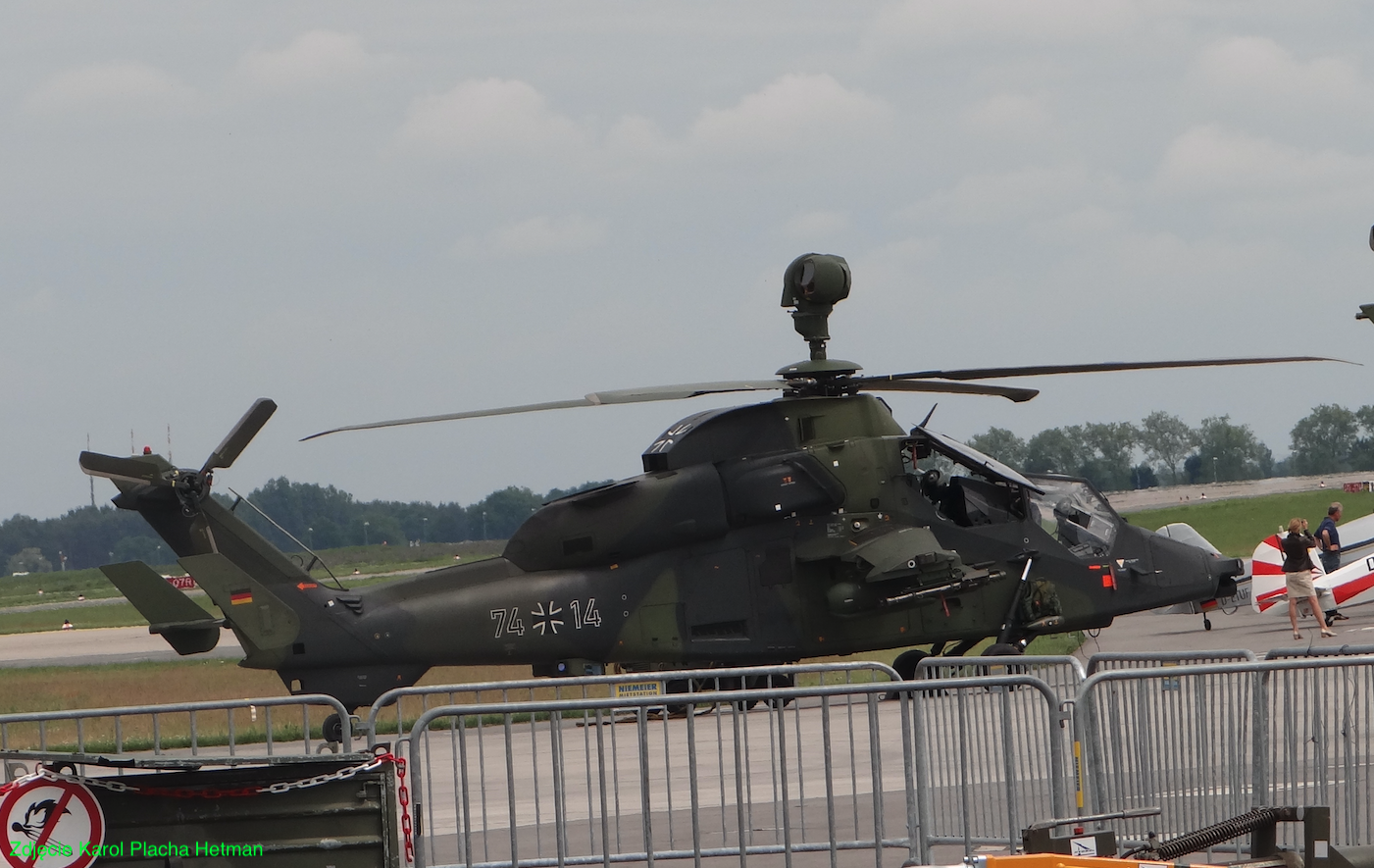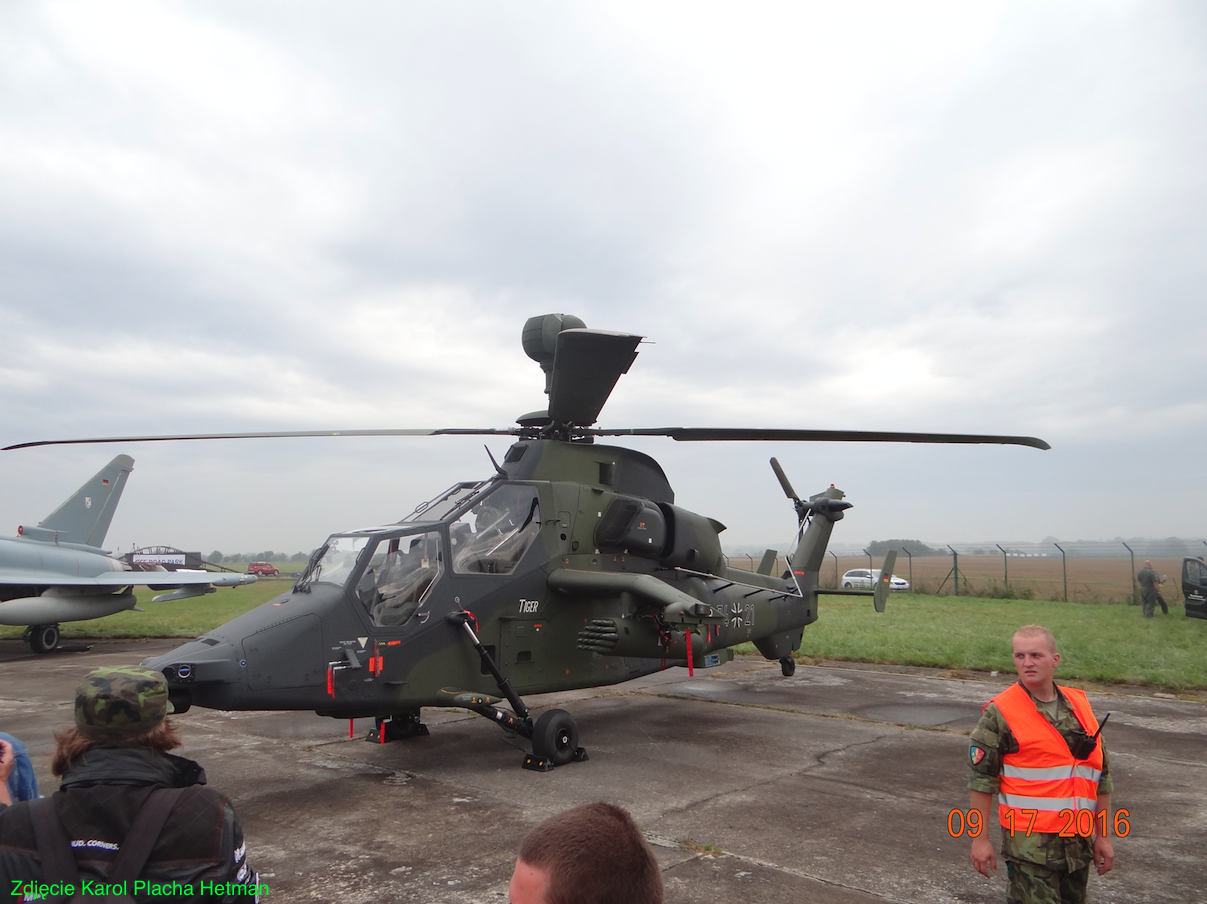Warszawa 2023-04-14
Eurocopter Tiger.
Eurocopter Tiger is an attack helicopter designed to operate directly on the battlefield. The helicopter prototype made its first flight on April 27, 1991. The helicopter is manufactured by Airbus Helicopters, formerly Eurocopter. Airbus Helicopters was formed from the merger of the respective helicopter divisions of Aérospatiale and DASA. The factory designation of the helicopter is EC.665. The Eurocopter Tiger helicopter was built in a classic layout. Two turbine engines were used for propulsion. It entered service only in 2003. By 2019, 180 were built. The helicopter is operated by the military: France, West Germany, Spain, Australia.
Helicopter development.
The development of the helicopter began in the 1980s, during the Cold War. In 1984, the governments of France and West Germany concluded an agreement to build a common helicopter platform. Its main task was to destroy Soviet armored weapons after the attack of the Moscow state on the West. Individual national versions were to differ in equipment and used armament. A joint venture between Aérospatiale and MBB was set up to implement the programme. However, it turned out that a joint program (France, West Germany) will be more expensive than if each country developed its own helicopter (?). In 1986, the program was canceled.
After a dozen or so months, the program was re-analysed. As a result of the analyses, the duration of the contract was extended for an indefinite period, which, however, hit private companies that wanted to be shareholders, because they could not wait to see the profits. In the field of electronics, only Thomson CSF remained.
The show resumed in November 1987. One design office was created, which included engineers from France and West Germany. At this point, more emphasis was placed on the anti-tank capabilities of the attack helicopter. In 1989, an agreement was signed to finance the program until the launch of two production lines, respectively; at the Aerospatiale plants in Marignane and the MBB plants in Donauwörth. It was decided to build five prototypes. The first prototype Tiger helicopter made its maiden flight on April 27, 1991.
However, the moment the EC.665 helicopter made its first flight, the CCCP fell apart and the Warsaw Pact was dissolved. It was planned to end the helicopter program. Finally, after several months, France and Germany decided to continue the program by modifying it. It was about expanding the combat capabilities of the helicopter. But the financing of the program was irregular, which significantly extended the research and development work.
In 1992, Aérospatiale and MBB merged to form the Eurocopter Group. This led to a significant consolidation of the aerospace industry and the Tiger project itself. However, work progressed slowly. It was not until 1996 that a type of a new generation of basic anti-tank missile was selected for the helicopter.
At the time, Türkiye was interested in entering the Tiger program. However, subsequent controversies between France and West Germany led to Turkey withdrawing from possible participation.
On June 18, 1999, West Germany and France publicly placed orders for an initial batch of 160 Tiger helicopters, 80 for each country, valued at €3.3 billion. On March 22, 2002, the first production helicopter rolled out. In the following years, the number of helicopters ordered was reduced. In 2008, the helicopters reached combat readiness.
At that time (2010) the price of one Eurocopter Tiger helicopter was 55 – 65 million USD. The helicopter was offered to many countries, but in the end it was bought only by Spain and Australia. Usually the helicopter lost to the Boeing AH-64 Apache helicopter. The Tiger helicopter was also offered to the Polish Army, replacing the Mil Mi-24 helicopters. But the Polish side has never expressed much interest in this construction.
Eurocopter Tiger design.
The helicopter is built in a classic layout. The machine has no cargo hold and is not suitable for evacuating wounded soldiers or delivering ammunition to the defenders.
The Tiger has a "glass cockpit" with tandem seating and is manned by a crew of two; the pilot occupies the front seat and the gunner sits in the back. Each crew member can manage weapon systems or basic flight controls, switching roles as needed. The Tiger’s hull is made of 80% carbon fiber reinforced polymer and Kevlar, 11% aluminum and 6% titanium. The entire tail section is made of composites, including the one-piece tail boom. The rotors consist of four blades, it is fiberglass composite. In the structure of the helicopter fuselage there is a mesh and foil made of copper and bronze, which constitute a negative mass, protecting against lightning and electrical surges.
The protection systems used on the Tiger include "Stealth" features. Aspects such as visual, radar, infrared and acoustic signatures have been minimized. The use of composite materials in the airframe resulted in a reduction in the cross section of the radar echo (RCS), infrared and acoustic signatures. The helicopter fuselage is armored and designed to withstand small arms fire and 23 mm (0.91 in) cannon shells. The helicopter is equipped with various radar and laser systems for warning and detecting incoming missiles.
The helicopter is powered by two MTU Turbomeca Rolls-Royce MTR390 turbine engines controlled by FADEC. Each engine is rated at 972 kW (1,303 hp). The main gear is rated for 60 minutes of dry running in the event of loss of lubrication. The fuel tanks are self-sealing.
The basic element of the helicopter sighting system is the "Ozyrys" opto-electronic head, usually mounted on a mast above the rotor. It is also possible to mount the head on the roof of the helicopter under the rotor. The crew can use helmet-mounted sights.
Data T-T Tiger:
Crew of two aviators. Hull length 14.08 m (46 ft 2 in). Height 3.83 m (12 ft 7 in). Main rotor diameter 13.00 m (42 ft 8 in). Main rotor area 132.75 m2 (1,428.9 sq ft). Curb weight 3,060 kg (6,746 lb). Takeoff weight 5,090 kg (11,222 lb). Maximum weight 6,000 kg (13,228 lb). Fuel 1,080 kg (2,381 lb). Top speed 290 km/h (180 mph, 160 kn). Range 800 km (500 mi, 430 nmi). Ferrying range 1,300 km (810 mi, 700 nmi). Usable ceiling 4,000 m (13,000 ft). Climb rate 10.7 m/s (2,110 ft/min).
Armament: one 30 mm (1.18 in) GIAT 30 cannon. 450 cartridges. Four hooks for armament.
Written by Karol Placha Hetman


